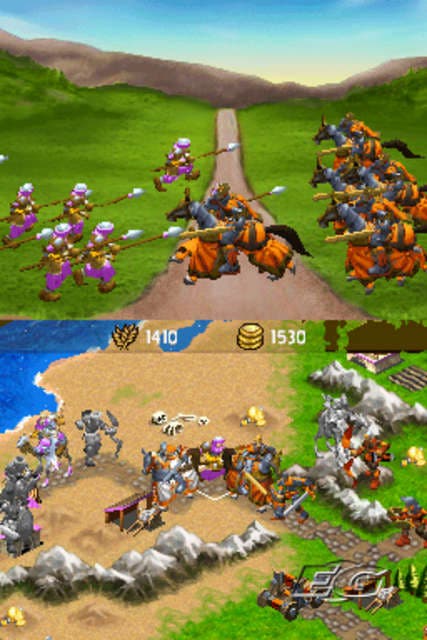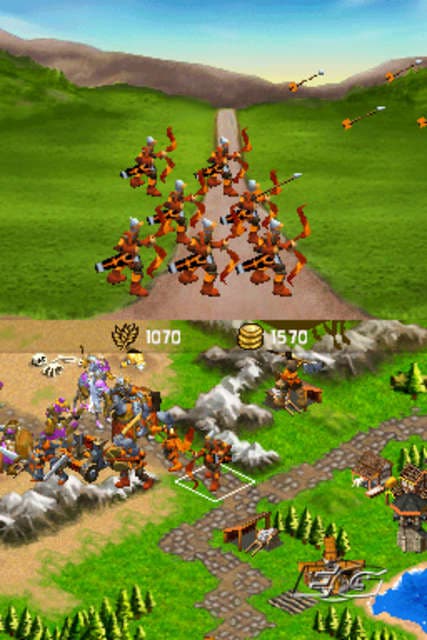Age of Empires: The Age of Kings
The art of shrinking thinking.
Let's hear it for turn-based strategy. Too often decried for being a plodding throwback to the 16-bit era, it's a tried and tested gameplay format that is long overdue a comeback. Real-time strategy is all very well but, a few notable exceptions aside, most RTS games are more about the real-time and less about the strategy. Frantically harvesting resources and churning out combat units before click-dragging the whole bloody lot and flinging them at the enemy - there's not really much room for nuanced thought in that equation. By using the lowly chess approach, turn-based games force you to ponder, to think and to - hey! - strategise.
In transforming Ensemble Studios' flagship franchise to the diminutive DS, Backbone Entertainment has shaken things up in a mostly refreshing way - the most obvious change being the shift from RTS to turn-based play. The game has a few pressing flaws, of which more later, but none of them stem from the slowed-down pace. They've ignored last year's Age of Empires III and looked back instead to 1999, and Age of Empires II, for the foundations of this edition. It's a wise move. Wise because the third game was something of a disappointment, but also because its relatively lo-tech predecessor is a far more suitable candidate for the shrinking process required.
To Be This Good Takes Ages

Of course, shrinking is a relative term. By PC standards, this version is a cute diversion. By handheld standards, it's an absolute beast. There are five civilizations to command, each boasting unique strengths and weaknesses, as well as five or six historical scenario missions apiece. There are over 65 unit types, many exclusive to certain civilizations, and all finely balanced. There are 15 building types, each bringing distinct benefits to your battlefield ambitions. And there are also dozens of researchable technologies which boost your efficiency in key areas.
Coming in a week when Sid Meier hinted at bringing Civ to the DS, it's a tantalising display of how much can be crammed onto one of those dinky cards. Especially impressive is how Backbone has stripped the Age of Empires series down to its component parts and then reassembled them into something that looks and plays nothing like the previous titles, yet is still recognisable as Age of Empires. The conversion process hasn't been entirely successful, but we'll get to the nitpicky bits later.
Single-player games can take two forms. First is the empire specific Campaign Mode which leads you through some surprisingly detailed potted history lessons, requiring you to fulfil certain objectives along the way. The empires are ranked from Easy (Joan of Arc, whose missions also act as a tutorial) to Hard (Richard the Lionheart). Sprinkled in between are Yoshitsume, Genghis Khan and Saladin. It's accurate in that broad Braveheart manner, with characters like Robin Hood entering the fray, but it's still a slyly educational experience.
In It For The Long Haul

Rather than simply throwing you against an opposing force and asking you to emerge triumphant, the narrative flow of these campaign missions means that you'll find yourself tracking down holy relics, defending besieged cities or recreating legendary battles. Successful completion of mission objectives accrues points which can be traded in at the main menu for an additional eight specialist unit types and other goodies. Sometimes the task will require you to build towns and harvest resources. At other times, the mission will just be a test of your military mind. Rest assured, these campaign missions alone would be ample content for most games. Even Joan of Arc's introductory chapters boast hours of gameplay, and are hardly the pushover the "tutorial" tag suggests. If you want to work your way through all of them, you'd best set aside a few free months - or at least book some very long train journeys.
Additional to the campaigns is the more freeform Empire Map mode, which starts you off with your ruler, a military unit and a villager and lets you find your own way from there. There are twenty maps to choose from, with an extra 15 to be unlocked with your campaign points, so once again you're faced with an impressive array of choices.
Empire Map play is against one of three AI opponents, each of which can be set to one of three difficulty settings. Sadly, it's here that the first of several complaints begin to arise. Despite apparently having different temperaments, no matter which opponent I chose, or which difficulty level, the enemy always made a beeline for my fledgling empire with a suspiciously large military force and smacked the bejesus out of me. You can play against another person - either through the wireless hook-up, or simply by passing the console between you - and strategy fans with similarly inclined friends will get more satisfaction by playing this way.
Part of the problem is that these freeform maps are just too small - most measuring no more than 25x25 unit squares - so its inevitable that you'll clash with your neighbour sooner rather than later. This leaves you with precious little time to establish your presence, which in turn means you end up playing in the RTS style I grumbled about at the start, slipping into a cycle of "harvest, build, train, attack" that doesn't really inspire much long-term strategy beyond keeping your empire armed and aggressive.

